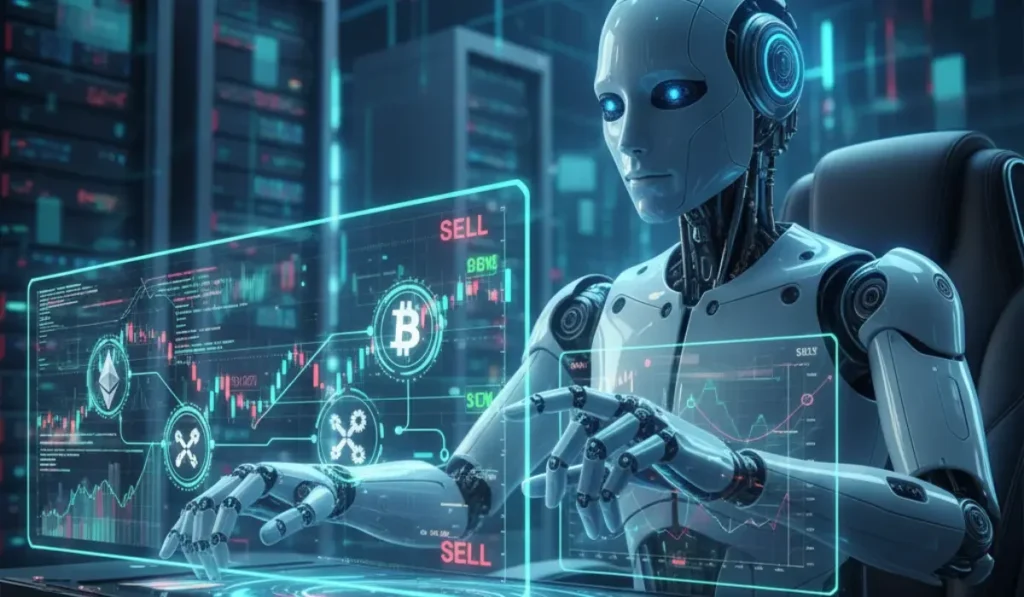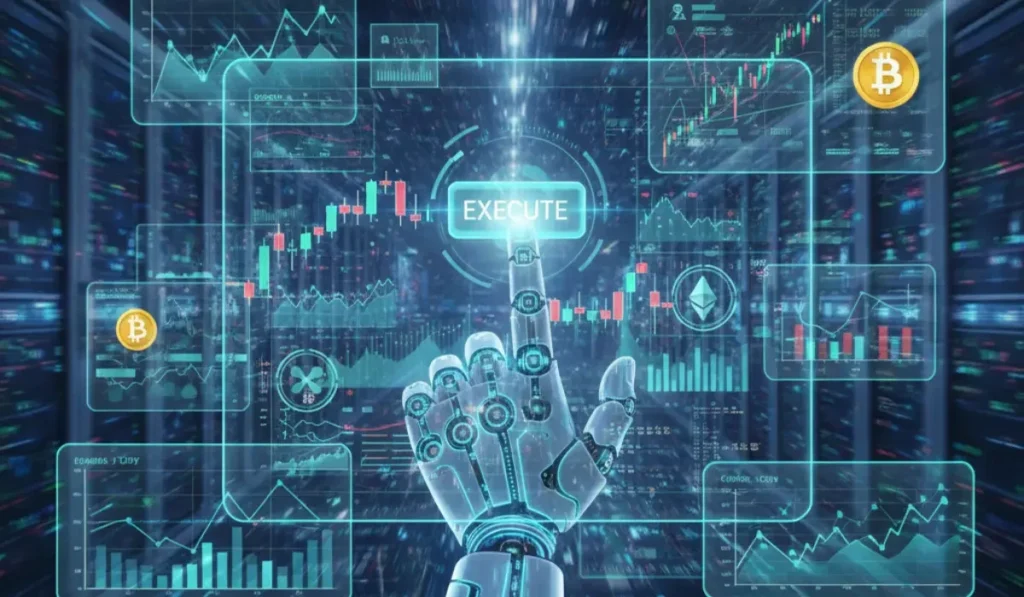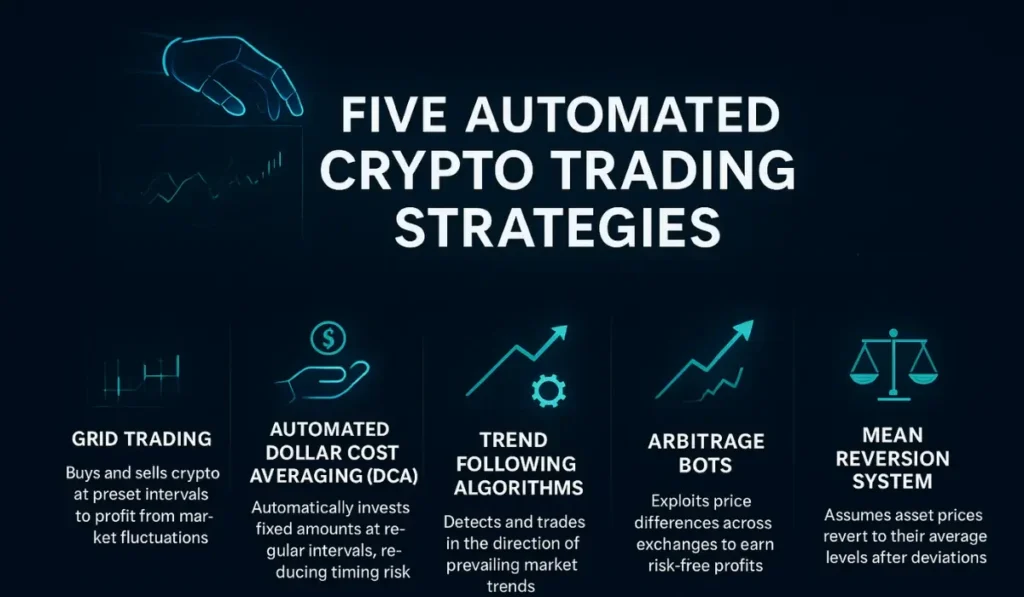Automated Crypto Trading Strategies (2025)

What is Automated Crypto Trading
When you are way too busy to execute trades yourself, you make use of bots, short for robots, to bid on your behalf. The use of such algorithmic systems to perform cryptocurrency trades is called automated trading. Automatic trading has gained popularity in recent years, with computational systems advancing over time.
Today, Automated Trading has become one of the most popular computer-based trading programs. Exchanges and brokerages offer Automated Trading as a feature, emphasizing the user’s interest in the whole process of trading with an algorithmic advantage. With nearly 36% of all crypto traders using AI to assist them in trading, Automated Crypto Trading seems to have a bright future.

Automated trading is of various types and can perform various strategies. They are a highly effective tool that enables split-second decisions while trading with precision. Courtesy of their technical advantage, these systems can analyze the market data, detect changes in indicator patterns, and react and place trades faster than manual traders.
What is the Use of Automated Trading?
Decision-making is an important aspect of trading. The right decisions at the right time can make a huge difference when it comes to trading cryptocurrencies. Often in manual trading, the emotional resilience is tested rigorously. By using an automated trading method, this emotional element is eliminated.
Fear, greed, and hesitation are some of the many emotions that drive wrong trading decisions. By implementing an algorithm to trade on our behalf, we can eliminate the negatives of the emotional element.
Speed and efficiency are two other reasons why traders like to use algorithmic/automated trading. A manual trade requires human attention, and placing a trade at the opportune moment requires precision and quick reaction times. In an ever-shifting world of crypto trading, this is almost impossible for a typical manual trader to execute with precision. So automated trading can be employed to fulfill fast and precise trading operations.

Besides placing trades fast, automated trading can make use of the 24/7 nature of the crypto market. Thus, no opportunity is missed as an automated system stays live, watching every single market movement.
Backtesting and optimization are yet another advantage of automated trading. These algorithms used for automated trading have built-in facilities to monitor different exchanges, prices, market movement, and technical indicators. These make the precision of the trade high. Additionally, traders can tweak and update their algorithms based on their trading preferences.
Flexibility, speed, precision, and resilience are all reasons that can be considered as positive parameters for using an automated trading system. Their popularity stems from their robust design, and today, exchanges offer in-house automated trading facilities under different names.
Also read: Best 5 Crypto Trading Strategies 2025
Five Automated Crypto Trading Strategies
In this section, we will be listing out five different strategies that will come in handy when you are planning on trading cryptocurrencies with an automated strategy. All of these five strategies have a different approach to trading; however, they maintain their key principles of consistency and rule-based execution, risk management, continuous monitoring, and observation.
We will be elaborating on each of these five different crypto trading strategies to uncover how each of these strategies helps in achieving different types of trading goals and the risks associated with them. The five types of automated crypto trading strategies are:
- Grid Trading
- Automated Dollar Cost Averaging(DCA)
- Trend Following Algorithms
- Arbitrage Bots
- Mean Reversion System

1. Grid Trading
The automated strategy where buy and sell orders are placed at regular intervals on strategic price points is what Grid Trading is all about. Here, there are no advanced technical systems trying to predict the market; rather, it makes use of the market’s volatility to place orders as price oscillations happen during the period of running the automated trade.
This type of automated trading requires the trader to fill in some initial parameters like upper and lower boundaries of the grid, spacing between each grid within the boundaries, and the position size of each trade.
Since Grid trading utilizes the power of price fluctuations, it is more suitable for a sideways market rather than a bullish or bearish market. This is one risk that traders take when it comes to deploying automated Grid trading. If the market moves consistently in one direction, traders may lose their boundary advantages, and the bot may stop midway once either of the two boundaries is crossed.
To prevent the automated Grid trading system from accumulating losses, it is vital to have protective strategies in place. These include stop-loss levels, hedging, dynamic grids, etc.
2. Automated Dollar Cost Averaging(DCA)
In the above-mentioned automated trading system, a fixed amount is used to buy your choice of cryptocurrency at a fixed interval of time. This keeps repeating as per your funding status. This strategy is completely automated, so your bot will execute all the purchases for you 24/7.
This reduces emotional interference during brief bullish markets, where the profit-taking mentality can limit the amount of profit that can be achieved. Further, during bearish markets, this strategy helps avoid panic selling.
DCA uses the price spread over longer periods of time to average out the net buy price. This is a tried and tested method used extensively by traders who are not keen on taking high risks.
The advantage of DCA bots is that they can set up to make dynamic DCA trades. This means that the bot automatically and regularly buys more units when the price is down, and buys fewer units of crypto regularly when the price is up. By using this strategy, traders can beat the risk of increased volatility.
3. Trend Following Algorithms
As we reach Trend Following Algorithms, we are entering more complex territory. These are no ordinary bots that buy and sell at fixed prices. Neither are they bots that automate what manual traders do.
These are automated trading bots/strategies that make use of advanced algorithms that analyze the market movement using technical analysis to identify trends. After identifying the trends, these automated systems place trades accordingly.
By focusing on the longer-term direction rather than the short-term noise, this automated strategy reduces risk by making informed decisions and ensuring consistency in trades. To detect breakouts, these trend-following algorithms constantly monitor the market data. They also make use of indicators like moving average crossovers to identify momentum shifts.
Only when the signals are strong does the bot execute the trade; this ensures that the trade is placed and completed at the right time.
While the trend following strategy becomes particularly strong in markets with a strong directional momentum, sideways markets can pose a risk where the algorithm may struggle to find concrete data to place trades. If any misjudgment occurs, this can lead to losses. Prolonged sideways markets can mean that the algorithm may not execute a trade at all.
These risks need to be taken into account before trading using automated trend following algorithms.
4. Arbitrage Bots
These bots exploit price differences across exchanges. By trading with exceptional speed, arbitrage bots lock in profit in the blink of an eye. Their ability to monitor multiple markets simultaneously and execute trades with lightning speed makes them ideal for arbitrage trading.
These bots typically follow predetermined rules and setups. By scanning order books and pools, they are constantly on the lookout for potential opportunities. Once they find an opportunity, they execute it without hesitation, thus locking in the profit.
Technical difficulties can cause these bots to face price slippages and order execution failures, which are risks associated with the Arbitrage Bot automated crypto trading strategy.
5. Mean Reversion System
Mean reversion systems expect prices of an asset to return to its historic average. This is the basic working principle. When an asset’s price moves far away from its mean, the system signals the bot that there could be a potential reversal. The bot then buys undervalued tokens or sells overextended ones.
This strategy is heavily dependent on indicators like Bollinger bands, z-scores, and moving averages. The system makes use of these indicators for its valuation. By monitoring these indicators continuously, the bots execute trades when the thresholds are breached.
This strategy is a very disciplined approach that uses a data-driven approach to make decisions. Even though this automated strategy is helpful to bots in ranging markets, strong trends can offset their advantage. If prices do not revert as per calculations, this strategy can fail. It is hence imperative to have stop-loss and other protective measures to be used together with this strategy.
Conclusion
With speed, precision, and emotion-free trading as the key advantages offered by automated trading strategies, they are a great tool for trading cryptocurrencies. Traders can safely move through volatile markets by making use of tools like these.
While these systems operate consistently based on data-driven insights, they are not foolproof solutions that offer a 100% success rate. Proper configuration, continuous monitoring, and protective measures are essential to maximize their advantages. This is helpful for traders as they can safeguard themselves against unexpected market movements.
Thus, automated trading remains a reliable tool for traders who want to explore the many different options offered in crypto trading.
FAQs
It is the use of bots working on different algorithms to execute different crypto trading strategies.
It removes emotional decisions, increases speed, and allows 24/7 market monitoring.
No, automated crypto trading is not risk-free. Bots can face slippage, execution errors, or losses in strong market trends.
Yes, these strategies are helpful for beginners, given that they will monitor their trades, give the right parameters, and put failsafe methods to minimize risk.
No, automated crypto trading is subject to market volatility and other market parameters. They cannot guarantee profits.
Crypto & Blockchain Expert
